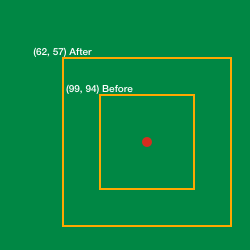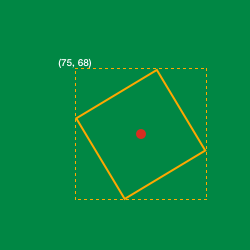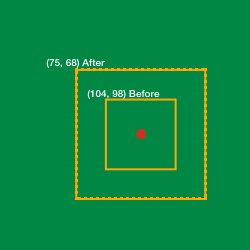Understanding UIView’s transform property (part 1)
Working with transform property of UIView might be frustrated at the first time. Confusion of using transform leads to difficulty in controlling UIView as well as persisting UIView information. This article helps demystify this.
Basics
Before going clarify transform property and how it works, let’s remind some basics. With a bunch of properties and methods in UIView, there are only four that we need in context of this article and the rest of it focuses only these four properties to try to explain how transform works.
frame- The frame rectangle, which describes the view’s location and size in its superview’s coordinate system.
bounds- The bounds rectangle, which describes the view’s location and size in its own coordinate system.
center- The center of the frame, i.e., it is location of the view’s center point in its superview’s coordinate system.
transform- Specifies the transform applied to the receiver, relative to the center of its bounds.
WARNING If this property is not the identity transform, the value of the frame property is undefined and therefore should be ignored.
These four properties have binding of each other, changes on one cause changes mostly on others. Simplest, for example, changes on center modify frame, and vise versa. We talk more about these relationships right below.
Relationships
frame changes
When frame changes, obviously, it causes change of bounds and center but remains transform. Changes on frame.origin and frame.size result in changes on center and bounds.size respectively.
frame.originchangescenterframe.sizechangesbounds.size
bounds changes
As bounds.size changes, the whole frame changes, I mean both frame.origin and frame.size. The reason is this change is relative to the view’s center point, the center point keeps the same while 4 corners move inward or outward depending on decreasing or increasing the size. System now reflects these changes to the view’s superview’s coordinate by change the view’s frame.

bounds.sizechangesframe.originandframe.size
frame.size is always equal to bounds.size on the other hand.
How about bounds.origin? It does not affect frame at all. It just shifts the view’s content, like the way you see in UIScrollView.
center changes
Because center and frame are both determined in superview ‘s coordinate system, i.e., they are in the same coordinate system, no wonder that they affect each other.
centerchangesframe.origin
transform changes
Now here is the most confusing of 4 properties. Don’t panic. It is purely mathematics. What, mathematics? It is even more scary. No, even if you are not math genius, understanding it must not be hard.
The idea is that transform is, simplified-explanation, a calculation being applied to a view to convert every single point inside the view to new position in the same coordinate system of the view’s superview. Keeping superview’s coordinate system untouched helps diminish effort to work with other views that do not use transform, i.e., transform is identity.
transform- input [some calculations happen here]=> output
As superview needs a straight rectangle to determine position and size of its child view, in case child view does not have one, e.g. it is rotated, superview uses a boundary to do this job. The boundary is the smallest straight rectangle that encloses completely the view.

Scale
Now let’s scale up and down a view. Recall the earlier explanation of transform, when scaling a view, in fact transform does not change real view’s size but only do conversion the size to new size in view’s superview and display it. This conversion, easy to guess, has effect on view’s frame.

transformchangesframe
What if we change frame after applied scale? Good question. Remember frame.size is always equal to bounds.size said earlier? New frame.size comes from old frame.size, actually comes from bounds.size. On forward way, bounds.size is as input and new frame.size is as output. And frame.size is as input and bounds.size is as output in reverse.
It is supposed to be but it is not unfortunately. As warning in transform, frame should be ignored. In fact, we still can use it to new frame value after scaled, as well as frame of boundary being mentioned right below, but it is not recommended to set value, even with frame.origin.
Therefore the answer is shouldn’t do.
Rotation
Now it is time for rotation. As in earlier figure, when a view is rotated, it does not longer have a straight rectangle to represent in its superview. This comes to superview needs a boundary to position and measure the view. The view’s frame now is actually the boundary’s frame and it does not literally reflect view’s position and size anymore.
transformchangesframe
Combination
In combination of scale and rotation, the same principle is applied.
In this part, we have better idea of 4 properties and their relationship. In the next one, we will talk more about transform, how to use it and applications, especially on persistence.